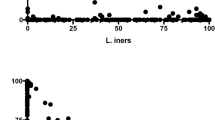Abstract
This study was conducted to determine the relationship between lactobacilli and bacterial species associated with bacterial vaginosis in pregnancy and the prevalence of H2O2-producing and non-producing strains of lactobacilli in pregnant women whose vaginal flora had already been analysed. Information was available for 174 pregnant women whose vaginal flora had been evaluated previously by examining gram-stained vaginal smears: 50 had grade III flora (bacterial vaginosis), 50 grade II flora, 41 flora graded as abnormal which then reverted to grade I (revertants) and 33 normal flora (controls). Lactobacilli were isolated from 19 of 50 women whose vaginal flora was grossly abnormal culturally and categorised as grade III by Gram staining. In 6 of these 50 women lactobacilli were isolated in large numbers, i.e. 105–106 cfu/ml. H2O2-producing strains of lactobacilli were isolated from 11 of 12 women with grade III flora who were randomly selected from this group. Thus, in those 11 women it appears that H2O2-producing lactobacilli had not protected them from developing bacterial vaginosis. Bacterial species associated with vaginosis were isolated in high numbers from a large proportion of women in the revertant and grade II groups in association with high counts of lactobacilli. Thus, in some women it is possible that a change to an abnormal flora could occur before the complete disappearance of lactobacilli. It is concluded that bacterial vaginosis may develop in some women despite the presence of H2O2-producing strains of lactobacilli and that other factors, as yet unidentified, might be conducive to the appearance of abnormal bacterial flora with progression to vaginosis.
Similar content being viewed by others
References
Hill GB, Eschenbach DA, Holmes KK: Bacteriology of the vagina. Scandinavian Journal of Urology and Nephrology 1985, Supplement 86: 23–39.
Reid G, Bruce AW, McGroarty JA, Cheng KJ, Costerton JW: Is there a role for lactobacilli in prevention of urogenital and intestinal infections? Clinical Microbiology Reviews 1990, 3: 335–344.
Redondo-Lopez V, Cook RL, Sobel JD: Emerging role of lactobacilli in the control and maintenance of the vaginal bacterial microflora. Reviews of Infectious Diseases 1990, 12: 856–872.
McGroarty JA: Probiotic use of lactobacilli in the human female urogenital tract. FEMS Immunology and Medical Microbiology 1993, 6: 251–264.
Eschenbach DA, Davick PR, Williams BL, Klebanoff SJ, Young-Smith K, Critchlow CM, Holmes KK: Prevalence of hydrogen peroxide-producingLactobacillus species in normal women and women with bacterial vaginosis. Journal of Clinical Microbiology 1989, 27: 251–256.
Hawes SE, Hillier SL, Benedetti J, Stevens CE, Koutsky LA, Wølner-Hanssen P, Holmes KK: Hydrogen peroxideproducing lactobacilli and acquisition of vaginal infections. Journal of Infectious Diseases 1996, 174: 1058–1063.
Rosenstein IJ, Morgan DJ, Sheehan M, Lamont RF, Taylor-Robinson D: Bacterial vaginosis in pregnancy — distribution of bacterial species in different Gram stain categories of the vaginal flora. Journal of Medical Microbiology 1996, 45: 120–126.
Hay PE, Lamont RF, Taylor-Robinson D, Morgan DJ, Ison C, Pearson J: Abnormal bacterial colonisation of the genital tract and subsequent preterm delivery and late miscarriage. British Medical Journal 1994, 308: 295–298.
Spiegel CA, Amsel R, Holmes KK: Diagnosis of bacterial vaginosis by direct Gram stain of vaginal fluid. Journal of Clinical Microbiology 1983, 18: 170–177.
McGroarty JA, Tomeczek L, Pond DG, Reid G, Bruce AW: Hydrogen peroxide production byLactobacillus species. Correlation with susceptibility to the spermicidal compound Nonoxynol-9. Journal of Infectious Diseases 1992, 165: 1142–1144.
Fontaine EAR, Taylor-Robinson D: Comparison of quantitative and qualitative methods of detecting hydrogen peroxide produced by human vaginal strains of lactobacillus. Journal of Applied Bacteriology 1990, 69: 326–331.
Fontaine EA, Claydon E, Taylor-Robinson D: Lactobacilli from women with or without bacterial vaginosis and observations on the significance of hydrogen peroxide. Microbial Ecology in Health and Disease 1996, 9:135–141.
Author information
Authors and Affiliations
Rights and permissions
About this article
Cite this article
Rosenstein, I.J., Fontaine, E.A., Morgan, D.J. et al. Relationship between hydrogen peroxide-producing strains of lactobacilli and vaginosis-associated bacterial species in pregnant women. Eur. J. Clin. Microbiol. Infect. Dis. 16, 517–522 (1997). https://doi.org/10.1007/BF01708235
Issue Date:
DOI: https://doi.org/10.1007/BF01708235




